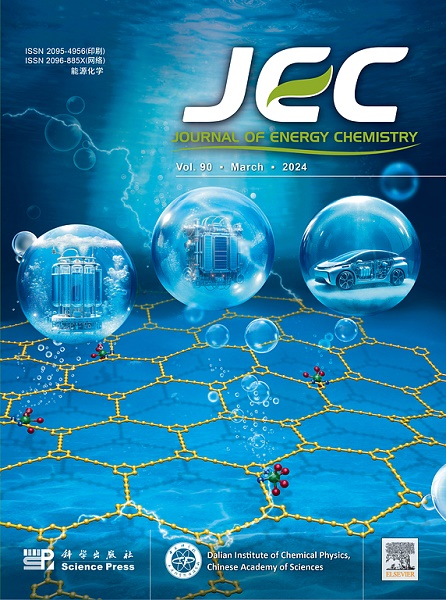Enhanced overall water splitting by CQDs-coupled RuO2-IrO2 heterojunction in acidic media
IF 13.1
1区 化学
Q1 Energy
引用次数: 0
Abstract
The development of highly active and stable bifunctional electrocatalysts in acidic media is crucial to hydrogen production by proton exchange membrane. In this study, we designed a RuO2-IrO2 heterostructure catalyst coupled by carbon quantum dots (CQDs). The catalyst showed excellent electrocatalytic performance for water splitting under acidic conditions. The overpotentials of oxygen evolution reaction (OER) and hydrogen evolution reaction (HER) were as low as 180 and 15 mV at 10 mA/cm2 in 0.5 M H2SO4, respectively. The acid electrolytic cell developed with RuO2-IrO2@CQDs as anode and cathode operated stably at 10 mA/cm2 for 120 h. In situ measurements and theoretical calculation reveal that the unique lattice oxygen mechanism path of RuO2-IrO2@CQDs can bypass the OOH* intermediate and breaks the linear relationship of adsorbent evolution mechanism path, resulting in higher OER catalytic activity.

cqds耦合的RuO2-IrO2异质结在酸性介质中增强了水的整体分裂
在酸性介质中开发高效、稳定的双功能电催化剂是质子交换膜制氢的关键。在这项研究中,我们设计了一种由碳量子点(CQDs)偶联的RuO2-IrO2异质结构催化剂。该催化剂对酸性条件下的水裂解具有良好的电催化性能。在0.5 M H2SO4中,析氧反应(OER)和析氢反应(HER)在10 mA/cm2下的过电位分别低至180 mV和15 mV。以RuO2-IrO2@CQDs为阳极和阴极的酸性电解槽在10 mA/cm2下稳定运行120 h。原位测量和理论计算表明,RuO2-IrO2@CQDs独特的晶格氧机理路径可以绕过OOH*中间体,打破吸附剂演化机理路径的线性关系,从而获得更高的OER催化活性。
本文章由计算机程序翻译,如有差异,请以英文原文为准。
求助全文
约1分钟内获得全文
求助全文
来源期刊

Journal of Energy Chemistry
CHEMISTRY, APPLIED-CHEMISTRY, PHYSICAL
CiteScore
19.10
自引率
8.40%
发文量
3631
审稿时长
15 days
期刊介绍:
The Journal of Energy Chemistry, the official publication of Science Press and the Dalian Institute of Chemical Physics, Chinese Academy of Sciences, serves as a platform for reporting creative research and innovative applications in energy chemistry. It mainly reports on creative researches and innovative applications of chemical conversions of fossil energy, carbon dioxide, electrochemical energy and hydrogen energy, as well as the conversions of biomass and solar energy related with chemical issues to promote academic exchanges in the field of energy chemistry and to accelerate the exploration, research and development of energy science and technologies.
This journal focuses on original research papers covering various topics within energy chemistry worldwide, including:
Optimized utilization of fossil energy
Hydrogen energy
Conversion and storage of electrochemical energy
Capture, storage, and chemical conversion of carbon dioxide
Materials and nanotechnologies for energy conversion and storage
Chemistry in biomass conversion
Chemistry in the utilization of solar energy
 求助内容:
求助内容: 应助结果提醒方式:
应助结果提醒方式:


